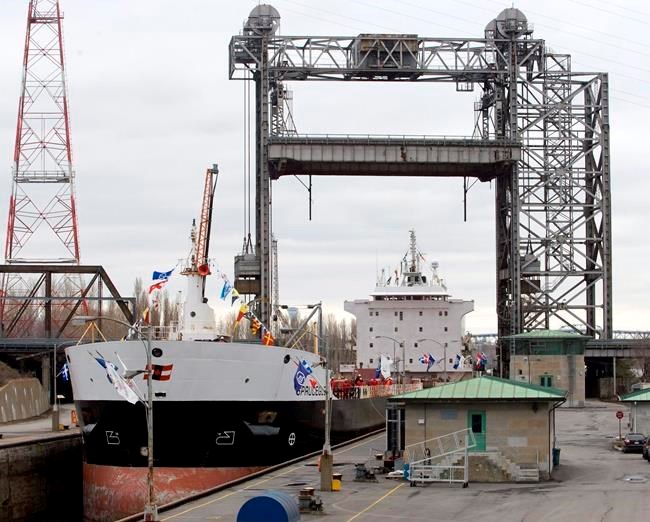The St. Lawrence Seaway officially opened Thursday for a 64th navigation season with the prospect of increased demand for Canadian grain and fertilizer stemming from the war in Ukraine.
Sanctions against Russia and devastation across Ukraine could dramatically disrupt the global supply of grain and fertilizer, especially to Europe.
Terence Bowles, president and CEO of the St. Lawrence Seaway Management Corp. that operates the waterway, said Canadian exports could be called upon to fill the void.
"I don't like to say it's going to help us because it looks like we're profiting from other people's troubles," he said in an interview.
"But I would say Canada is in a good position to be able to help replace a lot of this grain that won't be available."
Russian and Ukraine account for 29 per cent of global wheat exports and Russia is the world's largest exporter of fertilizers. But Ukraine is expected to lose five million tonnes of wheat exports through September because farmers are less able to plant amid Russian bombing and millions fleeing the country.
Canada's ability to respond to the disruptions will depend on the strength of the upcoming grain crop out of Western Canada and the U.S. Midwest after the most severe drought in 60 years devastated output last year, he said.
"So we have to all hope and pray that we're going to get a very good crop out West on grain because I guess we're going to need it."
Agriculture and Agri-Food Canada is forecasting that overall wheat production and exports will be at record lows for the crop year ending July 31 and be marginally better in 2022-23 as strong prices prompt farmers to plant more acreage.
"Based on the assumption of a return to trend or just below trend yields, total field crop production and supply is expected to return to a more normal level, resulting in carry-out stocks increasing but still remaining relatively tight as exports and domestic use bounce back from the low levels of the previous crop year," it wrote in its March report.
Bowles said the seaway is ready to deliver if there's another good year for Ontario grain and the western and U.S. grain crops come in stronger than expected. There is also an opportunity to ship corn and soybeans from Ontario and the U.S. while potash from Saskatchewan is an export opportunity due to a shift in buying patterns that exclude supply from Russian and Belarus.
Last week, Saskatchewan-based Nutrien said it is increasing its potash production by about 20 per cent in response to the uncertainty of supply from eastern Europe as Russia's invasion of Ukraine continues.
Some of the grain exports that have gone in the past to China could also move east this year to Europe, including Ukraine, Bowles said.
Meanwhile, sanctions against Russia will little impact on imports to Canada. The seaway handled just 424,000 tonnes of steel, slab and fertilizer imports from the country last year.
The seaway is forecasting that overall cargo shipments will remain flat at about 38.2 million tonnes this year, after increasing just 1.1 per cent in 2021, or up almost 13 per cent, excluding grain.
Cargo shipments excluding grain this year should be in line with the forecasted four per cent economic growth. Bowles said the increase is predicated on COVID being "in the rearview mirror as far as affecting people not people able to work."
The seaway was officially opened with Trillium class bulk carrier CSL Welland being the first ship of the season passing through the Welland Canal in St. Catharines, Ont.
Federal Transport Minister Omar Alghabra was scheduled to attend the event virtually.
He said the government's top priority is keeping supply chains moving, noting that the seaway supports 92,000 jobs and moves $17 billion in trade annually.
"As we enter a phase of recovery following the COVID-19 pandemic, we are committed to keeping our economy strong and will continue investing in projects along this essential transportation corridor," he said in a statement.
This report by The Canadian Press was first published March 24, 2022.
Ross Marowits, The Canadian Press




